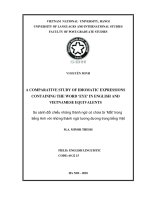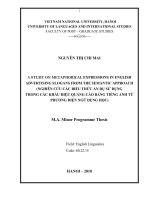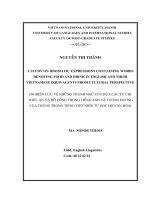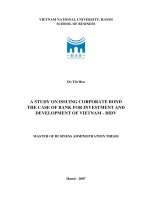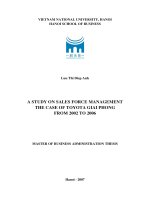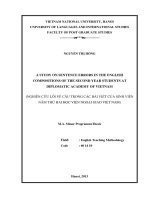A study on idiomatic expressions containing the word water in english and nước in vietnamese
Bạn đang xem bản rút gọn của tài liệu. Xem và tải ngay bản đầy đủ của tài liệu tại đây (219.79 KB, 26 trang )
MINISTRY OF EDUCATION AND TRAINING
UNIVERSITY OF DANANG
NGUYỄN VĂN KHIẾU
A STUDY ON IDIOMATIC EXPRESSIONS
CONTAINING THE WORD “WATER” IN
ENGLISH AND “NƯỚC” IN VIETNAMESE
Field
Code
:
: The English Language
60.22.15
MASTER THESIS IN SOCIAL SCIENCES
AND HUMANITIES
(A SUMMARY)
Danang, 2013
The study has been completed at College of Foreign Languages,
University of Danang
Supervisor: TRẦN QUANG HẢI, Ph.D.
Examiner 1 : Dr. Nguyễn Thị Quỳnh Hoa
Examiner 2 : Dr. Trương Bạch Lê
The thesis was orally defended at the Examining Committee
Time : June 9th , 2013
Venue : University of Danang
The Origin of the thesis is accessible for the purpose of reference at:
- The College of Foreign Languages Library, University of Danang
- Information Resourse Centre, University of Danang.
1
CHAPTER 1
INTRODUCTION
1.1. RATIONALE
Each nation has its own language. People naturally speak the
language spoken by their forefathers. However, English has had
worldwide recognition for ages and becomes the most popular
language. Especially, in open-door period and the trend towards
internationalization, English has become an essential tool in
international communication and integration. Therefore, the need for
learning English is increasing not only in quantity but also in quality.
Apart from learning practical English for daily communication, for
future jobs, for professional advancement, or for knowledge about
England - its people, customs and culture – learners study the theory
of its language to get a thorough insight into the language. Thanks to
this language, we can belong to the world as well as to our own
country, and especially using idioms is very important in everyday
communication for the following reasons.
Firstly, idiomatic expressions play an important part in a
language both in written and spoken forms. The most effective and
interesting way in communication is using idiomatic expressions
because they contain not only the literal meanings but the figurative
and expensive meaning as well. They are an integral part of a
language and they make the language more beautiful and dynamic.
In English the demand for using idiomatic expressions is becoming
higher because it is spoken all over the world.
Secondly, idiomatic expressions cause us many difficulties
in communication. Though idioms help speakers and writer
communicate more effectively and make the language more
2
interesting, they are not easy at all for everyone to use and master
idioms appropriately. Listeners and readers also find it really hard to
understand idioms because their meanings cannot often be deduced
from the individual components. Idioms are used both in written and
spoken language to emphasize meanings and make our observation,
judgment and explanations more lively and interesting, so they have
aesthetic function. In other words, they are really useful tools for
communicating a great deal of meaning in just a few words. For
example, to express a difficult situation that is hard to deal with the
English people often say “to be in deep water” or to be critical of a
plan that others thought was exciting or great they would like to say
“to pour cold water on something”. If we want to indicate that
someone feels awkward or uncomfortable because he is in a situation
which he has not experienced before, we use the idioms “To be like
a fish out of water”. If we want to talk about floating life, the
Vietnamese say “bọt nước cánh bèo”. We are attracted by the
questions how and why idioms differ from each other between
English and Vietnamese in case of idioms containing the word
“water”.
For these reasons above, I have decided to do research into
the topic entitled “A study on idiomatic expressions containing the
word ”water” in English and “nước” in Vietnamese” with a
strong. I desire to help learners to achieve proper comprehension and
usage of English idioms containing the word “water” in English
and“nước” inVietnamese.
3
1.2. SIGNIFICANCE OF THE STUDY
1.3. AIMS AND OBJECTIVES
1.3.1. Aims
The study is aimed at finding out the syntactic and semantic
characteristics of English idiomatic expressions containing the word
“water” and “nước” in Vietnamese. More importantly, it provides
Vietnamese learners of English with a basic knowledge of the field
and enables them to deeply understand, effectively and naturally, use
idioms in listening, speaking, reading and writing. To some extent,
they can be better aware of the beauty of English.
1.3.2. Objectives
- Identify and describe the syntactic features of English
idiomatic expressions containing the word “water” and “nước” in
Vietnamese.
- Identify and describe the semantic features of English
idiomatic expressions containing the word “water” and“nước” in
Vietnamese.
- To offer some implications for teaching and learning
English idiomatic expressions containing the word “water” and
“nước” in Vietnamese.
1.4. SCOPE OF THE STUDY
We wish to confine ourselves to studying idiomatic
expressions containing the word ”water” and “nước” in Vietnamese
in terms of syntactic and semantic features. The similarities and
dissimilarities in syntactic and semantic features withdrawn from the
study could not be explained on the basis of the cultural features of
the languages in comparison.
4
1.5. RESEARCH QUESTIONS
1. What are the syntactic and semantic characteristics of
English idiomatic expressions containing the word “water” and
“nước” in Vietnamese?
2. What are the similarities and differences between English
idiomatic expressions containing the word “water” and “nước” in
Vietnamese in terms of syntax and semantics?
3. What are some suggestions for teaching and learning
English idiomatic expressions containing the word “water” and
“nước” in Vietnamese?
1.6. ORGANIZATION OF THE STUDY
The research includes five chapters as follows:
Chapter 1: “Introduction
Chapter 2: “Literature Review and Theoretical Background”
Chapter 3: “Research Design and Methodology”
Chapter 4: “Findings and Discussion”
Chapter 5: “Conclusion and Recommendation”
5
CHAPTER 2
LITERATURE REVIEW
AND THEORETICAL BACKGROUND
2.1.
AN
OVERVIEW
TO
THE
PREVIOUS
STUDIES
RELATED TO THE RESEARCH
Up to now, there have been many researchers who pay attention
to idioms. Mc Marie with “English Idiom and How to Use them”
(published in 1909), is considered among the first authors to study on
the field of English Idioms. Other authors include Smith with “Idioms”
(1922), Collins with “A book of English Idioms with Explanation”
(published in 1958), Broke with “Idioms for Everyday Use”
(published in 1994), Cowries, Martin and Cairo with “Oxford
Dictionary of Current idiomatic English” (published in 1994), Quick,
Douglas Bibber, Rod Bonito and many other authors with “Longman
Idiom Dictionary” ” (published in 1998), Teachers and Researchers
from Cambridge University with “Cambridge International Dictionary
of Idioms” (published in 1999). Idioms also attract the attention of
many Vietnamese researchers Nguyễn Lực, Lương Văn Đang, are two
authors who made a significant contribution in the field of Vietnamese
idioms. They wrote “Thành Ngữ Tiếng Việt” which is a collection of
Vietnamese idioms arranged in alphabetical order with clear
explanations and examples extracted from Vietnamese novels,
newspapers and magazines.
2.2. THEORETICAL BACKGROUND
2.2.1. Definition of Idioms
As for F.R.Palmer [27], “an idiom is an expression whose
meanings cannot be inferred from the meaning of its parts”.
6
2.2.2. Idiomatic expressions containing the word “Water”
a. Definition of “water”
+ Word- classes
“Water” belongs to different word classes depending on the
meaning, form and position of the word in a sentence.
“Water” is a verb, such as “water down” or “water
something down”.
“Water” is a noun as in “in hot water”.
+ The meaning of “water”
“Water” is used to denote a situation that somebody deals
with in life.
In addition, “water” is used to indicate the quantity or
frequency of doing something.
Or “water” is used to express the quatity of doing something,
b. Definition of idiomatic expressions containing the word
“Water”
EIW are a special kind of idioms in which the word “water”
is a key word. In addition, EIW are one specific group of idioms that
demonstrate the way people use EIW in set expressions and how
they associate EIW with other things in the world.
2.2.3. Main features of idioms
a. Characteristics of English Idioms
+ Structural Features
An idiom is a fixed group of words. Each word is regarded
as a component of an idiom. An idiom can consist of at least two
components. Between them, it is impossible to add any other word.
+ Semantic features
7
According to Grains and Redman [22], “semantic opacity”
or “semantic ambiguity” can be considered as one of the
characteristic features of idioms.
2.2.4. Idioms and Other Language Units
a. Idioms and phrases
b. Idioms and Collocations
c. Idioms and Proverbs
2.2.5. Concepts of Semantic Fields
The term “Semantic Field” or “Semantic Domain” is used
alternatively for the term “lexical field” or “lexical set”.
Crystal [14, p.104] defines “a semantic and lexical field” as
“a named area of meaning in which lexemes interrelate and define
each other in specific ways”, such as the field of “fruit” comprises
the lexemes: apple, orange, banana, pear, peach…
2.3. SUMMARY
8
CHAPTER 3
RESEARCH DESIGN AND METHODOLOGY
3.1. RESEARCH DESIGN
Syntactic, semantic similarities and differences of EIW and
their Vietnamese equivalents will be discovered based on the
description, contrast, induction, deduction. The qualitative research
design is used and supported by an empirical study of data collected.
3.2. RESEARCH METHODS
In this study, the descriptive, contrastive, deductive, inductive
and equivalent translational methods are used for finding out the
syntactic characteristics of EIW and “nước” inVietnamese.
3.3. PROCEDURES
3.4. SAMPLING
I choose the samples based on the following criteria:
-
I collect the idioms in English.
-
I collect EIW and “nước” in Vietnamese from
dictionaries and websites on the internet.
-
I choose English idiomatic expressions which contain
the word “water” and “nước” in Vietnamese.
3.5. DATA ANALYSIS
3.6. INSTRUMENTS FOR ANALYSIS
3.7. RELIABILITY AND VALIDITY
3.7.1. Reliability
3.7.2. Validity
9
CHAPTER 4
FINDINGS AND DISCUSSION
4.1. SYNTACTIC FEATURES OF EIW AND “NƯỚC” IN
VIETNAMESE
4.1.1. Phrase structures
a. Verb Phrases
+ English:
[1] Verb + Noun/NP/Adv.P (muddy the waters)
[2] Verb + Noun/NP +Adv (cut someone's water off)
[3] Verb + Someone/Something + Adv
(blow something/somebody out of the water)
[4] Verb + Prepositional Phrase (go through fire and water)
[5] To be +Prepositional Phrase (to be in low water)
+ Vietnamese
[1] V + Noun/ NP+ V + Noun/NP (Ăn cỗ đi trước lội nước
đi sau, bán nước buôn dân)
[2] Verb + Như + Noun/NP (ăn ở như bát nước đầy)
[3] Verb + Như + Noun + Verb (dâng lên như nước vỡ bờ)
[4] Verb/VP + Noun/NP (Cười ra nước mắt, dội nước lạnh)
[5] Verb + Như + Verb + Noun/NP (mưa như trút nước)
10
Table 4.1 Verb phrase structures of English idiomatic expressions
containing the word “water” and “Nước” in Vietnamese
ENGLISH
VIETNAMESE
[1] Verb + Noun/NP/Adv.P
[1] Verb + Noun/ NP+
Verb + Noun/ NP
VERB
PHRASE
[2] Verb + Noun / Noun
[2] Verb + Như +
Phrase +Adverb
Noun/Noun Phrase
[3] Verb + Someone /
[3] Verb + Như +
Something +Adverb
Noun + Verb
[4] Verb + Prepositional
[4] Verb/ Verb Phrase
Phrase
+ Noun/Noun Phrase
[5] To Be +Prepositional
[5] Verb + Như +
Phrase
Verb + Noun/Noun
Phrase
b. Noun Phrases
+ English
[6] Adj + Noun (murky waters, uncharted waters)
[7] Adj + Noun + Prepositional Phrase (big drink of water)
[8] Adj + Noun and Adj + Noun (deep water and hot fire)
[9] (Art) Noun/NP + Prep + Noun/NP (water under the
bridge, water over the dam)
[10] Noun/NP + and + Noun/NP (bread and water)
[11] Noun + Prepositional Phrase (water under the bridge)
[12] Noun/Gerund + Noun (water table, water proof)
11
+ Vietnamese:
[6] Như + Noun + Verb + Noun/NP(như cá gặp nước)
[7] Như + Noun + Với + Noun (như cá với nước)
[8] Như + Noun/NP (như nước thủy triều)
[9] Noun Phrase + Noun Phrase (cơm giời nước sông)
[10] Noun + Adj + Noun + Adj (ao tù nước đọng)
Table 4.2 Noun phrase structures of English idiomatic expressions
containing the Word “Water” and “Nước” in Vietnamese
ENGLISH
[6] Adjective + Noun
VIETNAMESE
[6] Như + Noun + Verb +
Noun/Noun Phrase
[7] Adjective + Noun +
[7] Như + Noun + Với +
Prepositional Phrase
Noun
NOUN
[8] Adjective + Noun and
[8] Như + Noun/Noun
PHRASES
Adjective + Noun
Phrase
[9] (Article) Noun/NP +
[9] Noun Phrase + Noun
Prep + Noun/NP
Phrase
[10] Noun/NP + and +
[10] Noun + Adj +Noun
Noun/NP
+ Adj
[11] Noun + Prepositional
X
Phrase
[12] Noun/Gerund + Noun
X
12
c. Adjective Phrases
+ English:
[13] Adj + Prepositional Phrase (dead in the water)
[14] Adj + as + Noun/Noun Phrase
+ Vietnamese:
[11] Adj + Noun + Adj + Noun (đục nước béo cò)
[12] Adj + Noun + Verb + Noun (đục nước thả câu)
[13] Adj/Adj.P+ như + Noun/NP (lạnh như nước đá)
[14] Adj + Noun (sạch nước cản)
[15] Adjective + như + Noun + verb (đông như nước chảy)
Table 4.3 Adjective phrase structures of English Idiomatic expressions
containing the Word “Water” and “Nước” in Vietnamese
ENGLISH
VIETNAMESE
[13] Adj + Prepositional [11] Adjective + Noun
ADJECTIVE
PHRASES
Phrase
+ Adjective + Noun
[14] Adj + as +
[12] Adj + Noun +
Noun/Noun Phrase
Verb + Noun
X
[13] Adjective/Adj.P+
Như + Noun/NP
X
[14] Adj + Noun
X
[15] Adjective + như +
Noun + verb
d. Prepositional Phrases
+ English:
[15] Prep + Adj + Noun (in deep water)
[16] Prep + Noun Phrase (of the first water)
13
[17] Prep + Noun and Noun (through hell and high water)
[18] Prep + Noun + Prepositional Phrase (like a fish out of
water)
+ Vietnamese
The structures of prepositional phrases in Vietnamese do not
contain in idiomatic expressions in Vietnamese, just in English.
Table 4.4 Prepositional phrase structures of English Idiomatic
expressions containing the Word “Water” and “Nước” in
Vietnamese
ENGLISH
VIETNAMESE
[15] Preposition +
X
Adjective + Noun
PREPOSITIONAL
PHRASE
[16] Preposition + Noun Phrase
X
[17] Preposition + Noun
X
and Noun
[18] Prep + Noun +
X
Prepositional Phrase
4.1.2. Sentence Structures
a. Simple Sentences
+ English
[19] S + Verb + C (blood is thicker than water)
+ Vietnamese
[16] S + Verb + O (chuồn chuồn đạp nước)
[17] S + Verb + A (nước mắt chảy quanh)
b. Compound sentences
+ English
[20] S + Aux + V + O + A, Conj + S + Aux + V + O + V
14
(you can lead a horse to water, but you can't make it drink)
[21] S + A + V + O, Conj + S + V + A (you never miss the
water till the well runs dry)
[22] S + Aux + V + A +Relative Pronoun + V + C (mill
cannot grind with water that is past)
+ Vietnamese
[18] S + V, S + V (nước chảy đá mòn)
Table 4.5 Sentence Structures of English Idiomatic expressions
containing the Word “Water” and “Nước” in Vietnamese
English
Patterns
Vietnamese
Number
%
Number
%
S + Verb + C
1
20
X
X
Sentences S + Verb + O
X
X
4
66.7
Compound S + Verb, S + Verb
X
X
2
33.3
Sentences S + Aux + Verb + O +
1
20
X
X
1
20
X
X
1
20
X
X
5
100%
6
100%
Simple
A, Conj + S + Aux +
Verb + O + Verb
S + A + Verb + O, Conj
+ S + Verb + A
S + Aux + Verb + A
+Relative
Pronoun
+
Verb + C
Total
15
4.1.3. The Structure of English idiomatic expressions
containing the word “water” and Vietnamese ones containing the
word “nước”.
a. Parallel structures
Sound Repetition
Rhyming Repetition
Accent Repetition
b. Comparative Structures
Table 4.6 A Summary of English Idiomatic expressions containing the
Word “Water” and “Nước” in Vietnamese in Grammatical Patterns
ENGLISH
VIETNAMESE
Phrase Structures
[1] Verb + Noun / Noun [1] Verb + Noun/ NP+
VP
Phrase/ Adv.P
Verb + Noun/ NP
[2] Verb + Noun / Noun
[2] Verb + Như +
Phrase +Adverb
Noun/Noun Phrase
[3] Verb + Someone /
[3] Verb + Như + Noun
Something +Adverb
+ Verb
[4] Verb + Prepositional
[4] Verb/ Verb Phrase
Phrase
+ Noun/Noun Phrase
[5] To Be +Prepositional
[5] Verb + Như + Verb
Phrase
+ Noun/Noun Phrase
[6] Adjective + Noun
[6] Như + Noun + Verb
+ Noun/Noun Phrase
NP
[7] Adjective + Noun +
[7] Như + Noun + Với
Prepositional Phrase
+ Noun
[8] Adj + Noun and Adj
[8] Như + Noun/Noun
+ Noun
Phrase
16
[9] (Article) Noun/NP +
[9] Noun Phrase +
Prep + Noun/NP
Noun Phrase
[10] Noun/NP + and + [10] Noun + Adj
Noun/NP
+Noun + Adj
[11] Noun +
X
Prepositional Phrase
[12] Noun/Gerund +
X
Noun
[13] Adj + Prepositional
[11] Adjective + Noun
Phrase
+ Adjective + Noun
[14] Adj + as +
Noun/Noun Phrase
X
ADJ. P
[12] Adj + Noun +
Verb + Noun
[13] Adjective/Adj.P+
Như + Noun/NP
X
[14] Adj + Noun
X
[15] Adjective + như +
Noun + verb
[15] Preposition +
X
Adjective + Noun
[16] Preposition +
PREP.P
X
Noun Phrase
[17] Preposition + Noun
X
and Noun
[18] Preposition + Noun
+Prepositional Phrase
X
Sentences
Compound Sentences
Sentence Structures
Simple
17
[19] S + Verb + O
[16] S + Verb + C
[20] S + Aux + Verb + O
[17] S + Verb + A
+ A, Conj + S + Aux +
Verb + O + Verb
[21] S + A + Verb + O,
[18] S + Verb, S +
Conj + S + Verb + A
Verb
[22] S + Aux + V + A
X
+Relative Pronoun + V + C
Table 4.7 Statistical Summary of Syntactic Features of English
Idiomatic expressions containing the Word “Water” and “Nước” in
Vietnamese
Structures
Sentence
Phrase Structures
English
Number
Vietnamese
Percent
(%)
Number
Percent
(%)
VP
46
51.1%
26
23.6%
NP
18
20%
50
45.5%
Adj. P
13
14.1%
29
26.4%
Prep. P
7
8.2%
0
0%
Simple
2
2.2%
2
1.8%
4
4.4%
3
27%
90
100%
110
100%
Sentences
Compound
Sentences
Total
18
4.1.4. Similarities and Differences in Syntactic Features
of English Idiomatic expressions containing the Word “Water”
and “Nước” in Vietnamese
a. Similarities
b. Differences
4.2. SEMANTIC FEATURES OF ENGLISH IDIOMATIC
EXPRESSIONS CONTAINING THE WORD “WATER” AND
“NƯỚC” IN VIETNAMESE
4.2.1. Transference of meaning of English Idiomatic
expressions containing the Word “Water” and “Nước” in
Vietnamese
a. Simile
b. Metaphor
c. Hyperbole
4.2.2. Semantic fields of English Idiomatic expressions
containing the Word “Water” and “Nước” in Vietnamese
a. Thorny Situation
b. Power
c. Nature
d. Living conditions
e. Emotion
f. Taking advantage
g. Personality
19
Table 4.8 Frequency of Semantic Fields of EIW and VIN
Semantic Fields of EIW and VIN
EIW and VIN
Word group
English
Vietnamese
Number
%
Number
%
1
Thorny Situation
18
20.2%
13
11.8%
2
Power
16
17.9%
14
12.7%
3
Nature
1
1.2%
10
9%
4
Living conditions
3
3.3%
11
10%
5
Emotion
4
4.5%
20
18.2%
6
Taking advantage
14
15.6%
9
8%
7
Personality
13
14%
12
11%
8
Others
21
23.3%
21
19.3%
90
100%
110
100%
Total
4.2.3. Similarities and Differences in Semantic Features
of English Idiomatic expressions containing the Word “Water”
and “Nước” in Vietnamese
a. Similarities
b. Differences
20
CHAPTER 5
CONCLUSIONS AND IMPLICATIONS
5.1. CONCLUSIONS
Idioms beautify the language and help to establish the
characteristics of each individual language.
As has already been stated, the purpose of this thesis is to
study the semantic and syntactic features of idiomatic expressions
containing the word “water” in English and “nước” in Vietnamese
and then find out the similarities as well as differences in Enghlish
and Vietnamese. We have started with 90 English idiomatic
expressions and 110 Vietnamese ones. Especially, after analyzing the
syntactic and semantic features of idioms both in English and
Vietnamese, we give the data tables in order to infer what the
common structures are used both in English and Vietnamese idioms.
Throughout syntactic and semantic fields we find out the similarities
and differences in English and Vietnamese idioms. Moreover, before
inferring any conclusion, we analyze each of idioms carefully as well
as carry out comparing and contrasting each English idiom and
Vietnamese one. From the discussion, we can recognize that every
country has different ways in using idioms in order to express what
they want to say or communicate to the readers, and basing on using
idioms, learners can enrich their knowledge of the cultures of the
other countries more easily and clearly. By using idioms, the
sentences are more beautiful and meaningful.
21
In this thesis, we aim at comparing and contrasting the
syntactic and semantic features of English and Vietnamese idioms
throughout investigating the syntactic and semantic fields.
Syntactically, EIW and VIN analyzed are under the phrasal
structures and sentence structures with the total of 22 patterns in
English and 18 ones in Vietnamese. The phrasal structures are
categorized into noun phrases, verb phrases, adjective phrases,
prepositional phrases. Sentence structures are presented in simple
and compound sentences. Besides, we also mention the parallel
structures of English and Vietnamese idioms in form of noun
phrases, verb phrases and adjective phrases. Apart from these, a
summary of the similarities and differences of syntactic features of
English and Vietnamese idioms is also provided.
Semantically, all EIW and VIN in this study express their
meanings via semantic transfer means such as metaphor, hyperbole
and simile. Especially, metaphor is used as the main stylistic device
in most of idioms in English as well as in Vietnamese such as in deep
water, in hot water and dội nước lạnh, đo lọ nước mắm đếm củ dưa
hành, đục nước béo cò, cờ lâm nước bí, etc in Vietnamese.
Hyperbole is used in some idioms such as spend money like water,
could talk under water, etc in English and nước sôi lửa bỏng, sắc
như nước, đi như nước chảy, nước mắt như mưa, tiền của (bạc) như
nước, etc in Vietnamese. Simile appears in some idioms such as like
water off a duck's back, etc in English and dâng lên như nước vỡ bờ,
mắng như tát nước, etc in Vietnamese.besides, these English and
22
Vietnamese idioms are presented in seven fields namely thorny
situation, power, personality, nature, emotion, taking advantage and
living conditions. Moreover, we can also find out some similarities as
well as differences in terms of semantic features.
5.2. IMPLICATIONS FOR TEACHING AND LEARNING
IDIOMS
Native speakers of English often use idiomatic expressions in
everyday life. Therefore, Vietnamese learners of English will not
understand what the speakers mean through idiomatic expressions in
communicating if they do not have knowledge of idioms.
From this, I would like to have some suggestions for language
teaching and learning idiomatic expressions to help Vietnamese
learners of English.
An important first step is exposing learners in comprehending
unknown idiomatic expressions. Learners should be encouraged to
infer the meaning of the idiomatic expressions by using contextual
clues or background knowledge. After presenting idioms in context
to help learners infer their meanings, teachers should revise the
idioms that have been studied. This can be done in some ways,
including typical exercises like matching idiomatic expressions to
their meanings, filling the blanks with the appropriate idioms,
replacing underlined expressions with an idiom, etc. Next, another
significant way is that teachers also provide learners with strategies
for dealing with figurative language. Through a greater awareness of
idioms, their literal meaning and underlying conceptual metaphors,
23
learners will be better equipped with figurative language and make
sense of it without teacher’s guidance.
Our view is that more emphasis should be put on the teaching
of EIW and VIN to Vietnamese learners of English at all levels in
order to raise their awareness in learning EIW and VIN.
For elementary and intermediate levels, in each lesson teachers
should provide idioms, explains and give examples of idioms clearly.
Learners should use tasks or exercises choosing the appropriate
idiomatic expression to substitute for the italicized word or words in
each sentence or filling in each blank with the appropriate form of an
idiomatic expression from this unit or answering these questions
orally in the lesson. This helps learners to remember the lesson
better.
For advanced levels, teachers should be sensible in dealing
with cultural differences between languages in order to provide more
precise explanations for the learners. The learners are help to use
idioms in practicing different communicative skills and choose
appropriate idioms in certain contexts.
Moreover, teachers should guide Vietnamese learners in:
- Using various dictionaries, course books and others to
check the correctness of idioms before using them.
- Finding idiomatic expressions in the daily speech of
English speaking people, in novels, books, newspapers and magazine
articles, idioms of expression abound.

